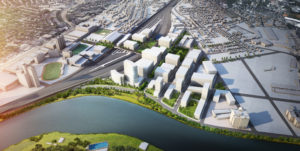How does a state department of transportation, in a single project: 1) renovate a failing highway structure; 2) adapt to changes in local land use; 3) reconnect a neighborhood to its waterfront via new parks; 4) improve local access to mass transit; and 5) make hundreds of acres of fallow infill land available to help revitalize the local economy?
The Massachusetts Department of Transportation is about to find out if they can accomplish all of that in one fell swoop.
A mammoth, long-planned highway renovation and redesign project is coming to fruition. On November 13, 2017 state officials said it will likely break ground in 2020. It will repurpose a dead rail yard, renew the property into mixed-use and public parks, and reconnect the community to its watersfront. It’s a great example of the 3Re Strategy (repurpose, renew, reconnect) in action.
The project, with one plan estimated to cost $1.2 billion, will replace a raised portion of the Pike where it takes a looping bend through now-abandoned rail yards. Besides adapting to the altered land use of the rail yard property, the I-90 Allston Interchange Improvement Project is also the result of the need to replace the structurally deficient, functionally obsolete Allston Viaduct.
As part of the construction, the state would build another commuter rail station, remove the labyrinth of twisting ramps and access roads, and create a more orderly grid with new streets, bike and walking paths, and possibly more parkland along the Charles River.
Besides revitalizing the local community by providing access to vast amounts of property for redevelopment, it will dramatically reshape the Massachusetts Turnpike in Allston and improve the commute (except during construction) of hundreds of thousands of motorists.
Transportation Secretary Stephanie Pollack says that the planned changes to the Allston Interchange, as it is known, are a “generational opportunity to use the space available to get the interstate right, get the road network right, and get the rail system right,”
With good design, this project is also an opportunity to dramatically reduce the footprint of the existing Allston Interchange toll plaza made possible by the implementation, through a separate project, of All Electronic Tolling (AET).
The southern limit of the project includes the CSX Beacon Park Rail Yard, just north of the Boston University Athletic Center. The northern limit of the work is in the vicinity of the I-90 Allston interchange ramps.
The project creates an opportunity to dramatically improve livability and connectivity for residents of the Allston neighborhood while preserving and enhancing regional mobility through improvements to I-90 and its abutting interchange and the creation of a new stop on the Worcester/Framingham Commuter Line to be known as West Station.
During the spring, summer, and fall of 2014, MassDOT and its design team worked closely with a task force composed of local residents, advocates, representatives of local institutions and businesses, and officials both elected and appointed, in concert with the Allston community at-large to develop a concept for the replacement of the Allston Interchange which includes:
- Complete streets improvements to Cambridge Street.
- Enhanced bicycle and pedestrian connectivity among the different parts of Allston touched by the project area and the Charles River.
- A significant transit enhancement in the form of West Station and Commuter Rail Layover which will provide access and operational improvements to the commuter rail and an intermodal focal point for local bus service.
- A realigned I-90 mainline, straightened to take full advantage of the safety enhancements made possible by AET.
- A replaced I-90 Allston Viaduct to ensure that this section of a critical regional highway can continue to safely and efficiently carry traffic to and from Boston.
- Connecting roadways between Cambridge Street and I-90 built, to the fullest extent practical and safe, on complete streets principles to clearly signal to motorists leaving the highway that they are entering a community.
Taken together, these elements represent a package of improvements which seeks to make I-90 and its abutting connections a less intrusive neighbor to the Allston community while still doing its crucial work as an Interstate interchange.
Betsy Taylor, a member of the MassDOT board, said private interests that benefit from the roads should bear some of the costs — and also called on activists who want more green space in the project to find outside funding as well.
Featured aerial photo of Allston Interchange and Beacon Park rail yard by Nick Allen via Wikipedia.

